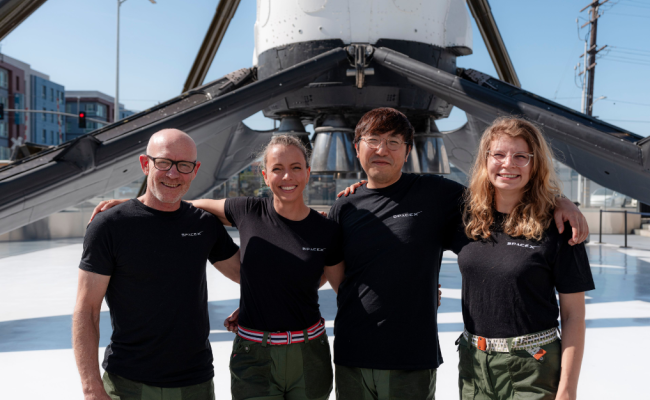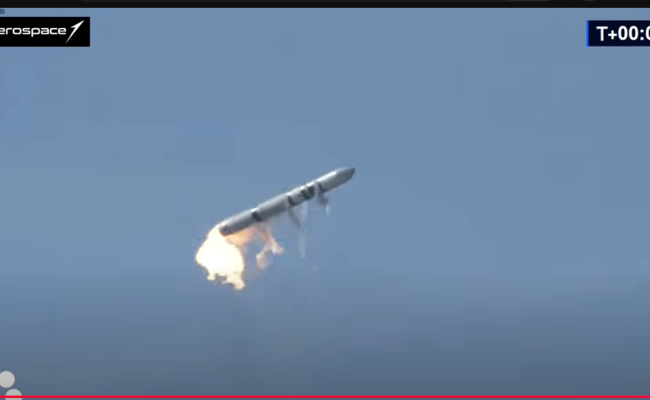First Human Spaceflight Over the Earth’s Poles Currently in Flight

The Fram2 crew members from the left: Eric Philips (Australia), Chun Wang (China/Malta), Jannicke Mikkelsen (Norway), and Rabea Rogge (Germany). (Photo: SpaceX)
The first human spaceflight over the Earth's polar regions is currently in flight. The crew will explore Earth from a polar orbit and conduct research designed to help advance humanity's capabilities for long-term space exploration. One of the crew members is Norwegian Jannicke Mikkelsen from Svalbard.
Last year, SpaceX announced plans for the first-ever human spaceflight over the polar regions.
On Monday, March 31, 2025, at 9:46 p.m. ET, the Dragon spacecraft was launched to a polar orbit from Launch Complex 39A at NASA's Kennedy Space Center in Florida, about 425-450 kilometers above Earth.
The mission, named Fram2 after the polar exploration ship Fram, aims to conduct research on human health in space and observe the Earth's polar regions from space.
The mission is funded and will be led by Chun Wang, a Chinese crypto entrepreneur based in Malta. Norwegian Jannicke Mikkelsen is the Vehicle Commander, German Rabea Rogge is the Vehicle Pilot, and Australian Eric Philips is the Medical Officer. None of the crew members have traveled to space before.
15 orbits a day
The astronauts have already orbited Earth many times after entering orbit and will pass the North and South Pole over fifty times during the mission, 15 times a day.
You can follow the Dragon spacecraft here.
The mission will last three and a half days before a parachute landing off the coast of California. The mission may be expanded if the weather conditions are too poor for the scheduled landing.
Flying in a polar orbit takes a lot more energy than flying in an equatorial orbit, which follows Earth's natural rotation. However, it does not leave any blindspots and allows the crew members to observe and photograph the North and South Poles, which are invisible to astronauts on the International Space Station and to all previous human spaceflight missions, except for the Apollo lunar missions, but only from far away.
Scientific mission
During the next few days, the crew will conduct 22 science and research experiments to "help advance humanity's capabilities for long-duration space exploration and understanding of human health in space," says SpaceX on their website.
The crew will take the first x-ray in space, perform exercise studies to maintain muscle and skeletal mass, study sleep patterns using the Finnish smart ring Oura, and grow mushrooms in microgravity.
They will also conduct a women's health study to analyze how microgravity and space radiation impact female reproductive hormones.
Additionally, after safely returning to Earth, the crew plans to exit the Dragon spacecraft without additional medical and operational assistance, helping researchers characterize astronauts' ability to perform unassisted functional tasks after short and long durations in space.
First Norwegian woman in space
Vehicle Commander Jannicke Mikkelsen has now made history as the first Norwegian woman in space. She is a film director and cinematographer living in Svalbard. She specializes in fringe technology, creating next-generation technology for movies shot in remote and hazardous environments such as the Arctic, ocean, aviation, and space.
“As a filmmaker, I have long dreamed of these possibilities in fiction. Now, step by step, commercial mission by commercial mission, we are turning those dreams into reality," she says in a statement on Fram2's website.
Citizen science project
Mikkelsen has brought her state-of-the-art photographic equipment with her, which she will use when the crew is to observe green fragments and mauve ribbons of continuous emissions similar to the atmospheric phenomenon known as STEVE (Strong Thermal Emission Velocity Enhancement), typically seen at altitudes of 400–500 km.
This will contribute to the collection of data for a Norwegian research project called SolarMaX.
According to the Norwegian Space Agency, the imagery taken from the spacecraft will be combined with images taken by a global network of photographers and citizen scientists on the ground, as well as data from several aurora observatories, to form a volumetric understanding of the aurora phenomena.




